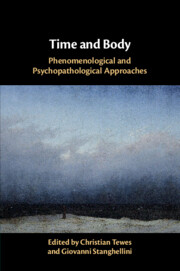Book contents
- Time and Body
- Endorsements for Time and Body
- Time and Body
- Copyright page
- Dedication
- Additional material
- Contents
- Figures
- Contributors
- 1 Introduction – Time and Body
- 2 Time, the Body, and the Other in Phenomenology and Psychopathology
- Part I Body and Time: General Aspects
- Part II Grief and Anxiety
- 7 Bereavement and the Meaning of Profound Feelings of Emptiness
- 7.1 Commentary on “Bereavement and the Meaning of Profound Feelings of Emptiness: An Existential-Phenomenological Analysis”
- 8 Body-as-Object in Social Situations
- 8.1 Commentary on “Body-as-Object in Social Situations: Toward a Phenomenology of Social Anxiety”
- Part III Borderline Personality and Eating Disorders
- Part IV Depression, Schizophrenia, and Dementia
- Index
- References
8 - Body-as-Object in Social Situations
Toward a Phenomenology of Social Anxiety
from Part II - Grief and Anxiety
Published online by Cambridge University Press: 30 October 2020
- Time and Body
- Endorsements for Time and Body
- Time and Body
- Copyright page
- Dedication
- Additional material
- Contents
- Figures
- Contributors
- 1 Introduction – Time and Body
- 2 Time, the Body, and the Other in Phenomenology and Psychopathology
- Part I Body and Time: General Aspects
- Part II Grief and Anxiety
- 7 Bereavement and the Meaning of Profound Feelings of Emptiness
- 7.1 Commentary on “Bereavement and the Meaning of Profound Feelings of Emptiness: An Existential-Phenomenological Analysis”
- 8 Body-as-Object in Social Situations
- 8.1 Commentary on “Body-as-Object in Social Situations: Toward a Phenomenology of Social Anxiety”
- Part III Borderline Personality and Eating Disorders
- Part IV Depression, Schizophrenia, and Dementia
- Index
- References
Summary
The aim of this chapter is to explicate the relationship among social anxiety, bodily experiences, and interpersonal contact with others. In so doing, I will first revisit the phenomenology of bodily experiences and confirm the difference between the body-as-subject and the body-as-object. Next, I will describe the experiences of one's body-as-object for others, distinguishing them from those of one's body-as-object for oneself. Among phenomenologists, it was Sartre (1943/1956) who emphasized the former aspect of bodily experiences as the “third ontological dimension of the body.” On the basis of this notion, I will try to develop a phenomenology of social anxiety as well as its disorder. In its most basic form, social anxiety can be described as a feeling of uncertainty of the other's mind that becomes salient in social situations.
Keywords
- Type
- Chapter
- Information
- Time and BodyPhenomenological and Psychopathological Approaches, pp. 150 - 169Publisher: Cambridge University PressPrint publication year: 2020



